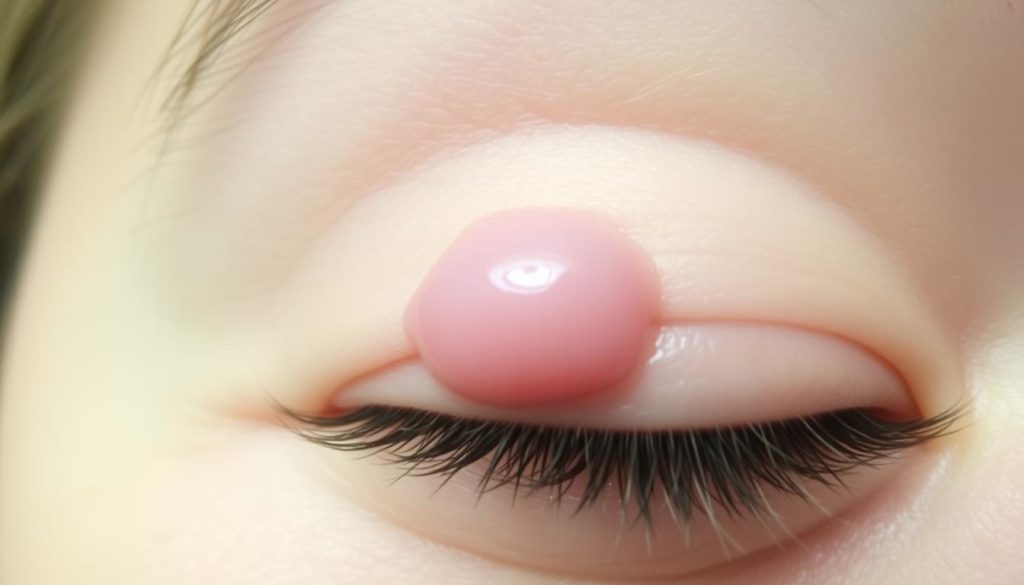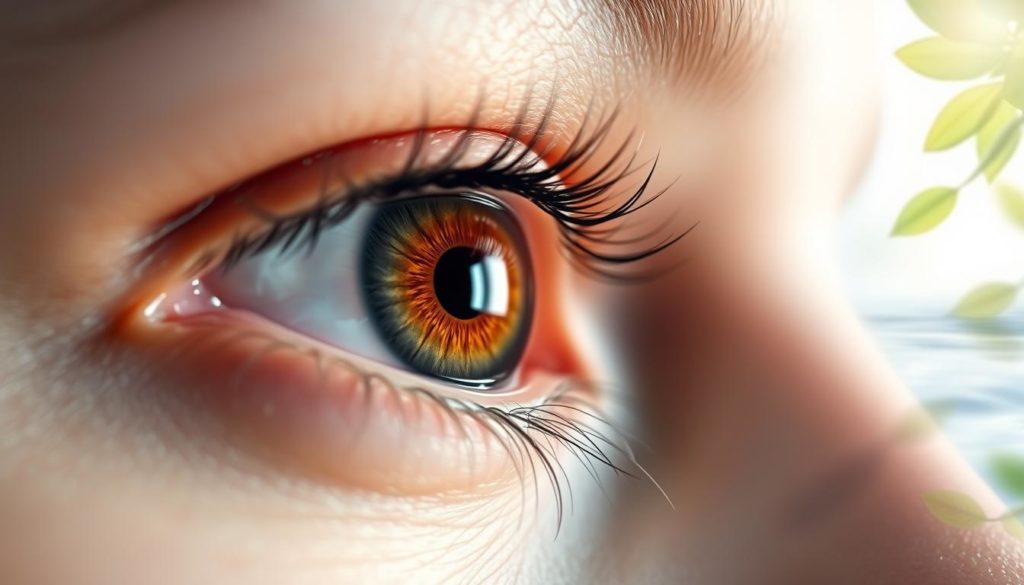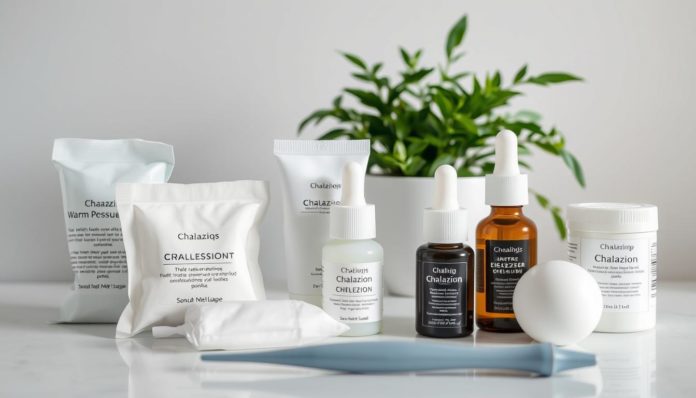Did you know that a chalazion makes up about half of all eye lumps? It’s important to know about chalazions, their causes, and how to treat them. This keeps your eyes healthy.
A chalazion might start small but can become a big problem if ignored. This guide will help you understand chalazions. It covers early signs, treatments, and how to prevent them. If you’re dealing with a chalazion or just want to keep your eyes healthy, you’re in the right spot.
What is a Chalazion?
A chalazion is a common eyelid bump. It happens when one of the meibomian glands gets blocked. These glands are small and make oil for the eyelids. If a gland doesn’t work right, it can create a swollen eyelid. This looks like a painless bump. It’s different from a stye, which hurts and comes from an infection.

To really get what a chalazion is, we should know how it differs from other issues. A chalazion is deeper in the eyelid and doesn’t make the eyelid as red or sore as other conditions. The bump might get bigger over time. It could hurt a bit if it pushes on the cornea.
Looking closer, the meibomian glands help keep eyes healthy by providing lubrication. If these glands are blocked, oil can’t get out. This leads to inflammation and a lump. This problem is often linked to ongoing conditions like blepharitis or getting styes often.
| Condition | Symptoms | Causes | Difference |
|---|---|---|---|
| Chalazion | Painless bump, swollen eyelid | Meibomian gland dysfunction | Not caused by infection |
| Stye | Painful red lump | Bacterial infection | Acute tenderness |
Common Causes of Chalazion
It’s important to know why a chalazion happens for better eye care. We’ll look at the main reasons, such as eyelid inflammation and gland blockage. Recognizing these triggers helps in dealing with them.
Blocked Meibomian Gland
Meibomian glands are by your eyelids. They release oils to protect your eyes. If they get blocked, oil builds up and turns hard, causing a chalazion. Keeping your eyes clean, especially with warm compresses, can stop blockages.
Chronic Blepharitis
Blepharitis means your eyelids get inflamed often. It makes the meibomian glands get blocked easily. This might lead to crusty or flaky skin near your eyelashes. Cleaning your eyelids well can lower your chalazion risk.
Eye Infections
Eye infections, like styes, can turn into a chalazion if not treated. They make your eyelids inflamed, messing up the gland’s work. This raises the chance of blockages. Using the right medicine on time can stop infections from getting worse.

| Common Causes | Impact on Eyes | Preventive Measures |
|---|---|---|
| Blocked Meibomian Gland | Oil buildup and solidification | Frequent warm compresses |
| Chronic Blepharitis | Inflammation and crusting | Proper eyelid hygiene |
| Eye Infections | Severe inflammation and potential stye progression | Timely medication and treatment |
Early Symptoms of a Chalazion
Spotting chalazion symptoms early is key for effective treatment. It lets you lessen discomfort and stop the condition from getting worse. The first signs include changes in the eyelid area. Spotting these early makes care quicker.
Initial Swelling
Swelling is a clear early sign. It starts as a small bump on the eyelid. A chalazion is not painful at first, but swelling can grow and lead to discomfort. Noticing the swelling early on helps in treating it sooner.
Mild Pain or Discomfort
As the chalazion gets bigger, you might feel a bit of pain. While it’s not intense, it can worry you. The pain comes from swelling pressing on eye structures. Catching these small pains early helps manage the chalazion better.
Diagnosing a Chalazion
To spot a chalazion early, knowing the symptoms and getting a correct chalazion diagnosis is key. At the eye doctor’s, it starts with a professional eye examination. The doctor looks at the affected eyelid to see if it’s a chalazion or something else.
- Reviewing the patient’s medical history
- Examining the eyelid for swelling, tenderness, and signs of infection
- Using specialized tools to get a better view of the blocked gland
A detailed professional eye examination is essential. It’s because sometimes chalazions are mistaken for other issues, like styes or eyelid tumors. A right chalazion diagnosis helps choose the best treatment. This reduces pain and stops more problems.
With these measures, eye specialists can give accurate diagnoses. They use their knowledge and the latest ophthalmology tools. This ensures patients get the best care possible.
Home Remedies for Chalazion
Managing a chalazion at home can be simple with effective natural strategies. These home remedies are designed to ease symptoms and help heal. Let’s explore how:
Warm Compress
A warm compress is a top method for natural chalazion care. It softens the clogged oil in the gland and helps it drain. Follow these steps to apply it:
- Soak a clean cloth in hot water (not boiling).
- Wring out the excess water, ensuring the cloth is damp.
- Place the cloth over your eyelid for 10-15 minutes, repeating 3-4 times a day.
Eyelid Hygiene
Good eyelid hygiene is key in self-treating a chalazion. Cleaning the eyelids regularly can prevent more infections and speed healing. Here’s how:
- Use a mild, non-irritating baby shampoo diluted with warm water.
- Gently scrub your eyelids with a clean, soft cloth or cotton swab.
- Rinse thoroughly and pat dry with a clean towel.
Over-the-Counter Treatments
There are also over-the-counter options to help with chalazion symptoms. These treatments can reduce inflammation and ease discomfort:
- Artificial Tears: These keep the eye moist and lessen irritation.
- Topical Antibiotics: These are used for associated infections, though not always needed.
- Anti-inflammatory Ointments: They can decrease swelling and pain.
| Remedy | Benefits | Usage |
|---|---|---|
| Warm Compress | Encourages drainage and reduces swelling | 3-4 times daily for 10-15 minutes |
| Eyelid Hygiene | Prevents further infection | Daily with diluted baby shampoo |
| Artificial Tears | Reduces irritation | As needed |
| Topical Antibiotics | Treats infection | As directed |
| Anti-inflammatory Ointments | Reduces pain and swelling | As directed |
Medical Treatment Options
If home treatments don’t work for a chalazion, you may need medical help. Knowing your options and their effects is key when treating an eye infection.
Antibiotic Ointments
Doctors often suggest antibiotic ointments for chalazions, mainly if an infection is present. These ointments kill bacteria that can make things worse. Erythromycin and bacitracin are commonly used.
“Clinical studies have shown a significant reduction in chalazion size when treated with topical antibiotics,” states a comprehensive review in the American Journal of Ophthalmology.
However, it’s crucial not to misuse antibiotics as it can cause resistance. Make sure to follow your doctor’s instructions carefully for the best results.
Steroid Injections
Steroid injections are an option for stubborn chalazions. They are great at quickly lowering inflammation and swelling. Drugs like triamcinolone are usually used.
Research shows that steroid shots can clear up to 80% of chronic chalazions in one to two weeks. But, they might cause skin color changes and thinning where injected. Your eye doctor will weigh the risks before starting treatment.
Choosing the right treatment for a chalazion is important for a quick recovery. Always talk to a healthcare expert to find what’s best for you.
Chalazion Surgery
When other treatments don’t work, surgery becomes a good choice for chalazion removal. This surgery helps open the blocked Meibomian gland. It brings big relief and stops more problems.
The surgery includes a few important steps done carefully by an eye specialist:
- Anesthetic Application: The area is numbed with local anesthesia for a pain-free experience.
- Incision and Drainage: A small cut is made on the inside of the eyelid to drain the chalazion.
- Post-Surgical Care: After surgery, patients use antibiotic ointment and get instructions for care at home.
Knowing what happens after surgery helps patients ready themselves for a smooth recovery. Here are some common recovery steps:
- Immediate Relief: Most people feel less swelling and discomfort in a couple of days.
- Follow-up Visits: Check-ups with the doctor make sure healing goes well.
Many people find chalazion surgery really helpful, based on real-life outcomes.
| Aspect | Details |
|---|---|
| Success Rate | High, with more than 90% of patients healing completely. |
| Recovery Time | Usually 1-2 weeks with the right care. |
| Potential Complications | Minor, like brief swelling or slight discomfort. |
Choosing surgery for chalazion offers a reliable fix when other methods don’t work. It quickly brings relief to those affected.
Prevention Tips for Chalazion
A good eyelid care routine is key to preventing chalazions. By keeping your eyelids clean and looking after any health issues, you can cut down on the chance of these painful lumps.
Proper Eyelid Hygiene
Cleaning your eyelids well is vital for eye care. Here are some helpful hints:
- Choose a soft cleanser made just for eyelids. Products like Ocusoft work well.
- Put warm compresses on your eyelids often. This keeps the oil glands working right.
- Don’t touch or rub your eyes with unclean hands. This can bring in germs and other irritants.
- Always take off your makeup before sleeping. This helps keep the oil glands from getting blocked.
Managing Underlying Conditions
Some health problems can make chalazions more likely. It’s important to take care of these to help stop chalazions.
| Condition | Management Tips |
|---|---|
| Blepharitis | Keep them clean and use medicines your doctor gives you to control blepharitis. |
| Meibomian Gland Dysfunction | Use warm compresses and massage therapy to keep the oil glands clear. |
| Rosacea | Follow a good skin routine and eat right as suggested by a professional to lessen problems. |
Making these steps a part of your routine boosts your eyes’ health. And it helps stop chalazions from forming.
When to See a Doctor?
Sometimes, chalazions need a doctor’s care, even though you can treat many at home. It’s important to know when to get professional help. This prevents the problem from getting worse and ensures you get the right treatment.
- Persistent or growing chalazion: If the chalazion doesn’t improve after a few weeks of home remedies or continues to grow, it’s time to seek medical advice.
- Severe pain or discomfort: Significant pain or discomfort not alleviated by over-the-counter treatments might indicate the need for a specialist’s care.
- Impacts on vision: If the chalazion affects your vision, either by blurring it or causing other visual disturbances, professional evaluation is crucial.
- Signs of infection: Symptoms such as redness, heat, or pus coming from the chalazion area should prompt immediate medical consultation to avoid serious complications.
“Early intervention can prevent serious chalazion complications. Consistently monitoring symptoms and seeking timely advice from an eye specialist are key steps in maintaining eye health.”— Dr. Sarah Williams, Ophthalmologist
Ignoring these signs can cause bigger problems. So, remember these tips. Know when to get doctor’s help for your chalazion, beyond just home care.
Chalazion Causes and Treatment Summary
It’s important to know how to manage chalazions, a common eye issue. This chalazion care recap highlights main causes and treatments. Knowing what triggers a chalazion and how to deal with it is key.
Chalazions often start from blocked meibomian glands. They get worse with ongoing blepharitis and eye infections. Catching symptoms early, like swelling and discomfort, helps in treating them quickly.
To get a grip on chalazion care recap and treatments, here’s a quick guide:
- Home Remedies: Warm compresses and cleaning your eyelids can help with early signs. Some over-the-counter products also help.
- Medical Treatments: When home methods don’t work, doctors may suggest antibiotic creams or steroid shots.
- Surgical Options: Surgery is an option for tough cases, but usually as a last choice.
Preventing chalazions involves good eyelid cleanliness and handling conditions like blepharitis. Know when to see a doctor for the right treatment on time.
Additional Resources and Support
Looking for more on chalazion management? Many resources are out there to help. The American Academy of Ophthalmology is a great place to start. Their site gives tons of info on eye health. This includes articles and guides on chalazion care.
Joining chalazion patient support groups is also helpful. They provide emotional support and tips from those who’ve gone through similar issues.
WebMD is another excellent resource with a broad range of medical knowledge. It offers expert opinions on treating and preventing chalazion. The Mayo Clinic also has updated advice and materials for managing symptoms.
Don’t overlook online forums like Reddit’s Eye Health community or chalazion-specific forums. They’re good for sharing experiences and getting answers. These platforms help connect with others facing similar challenges. Accessing these resources and joining support networks can offer valuable insights and support for managing chalazion.
FAQ
What are the common causes of a chalazion?
A chalazion often comes from a blocked meibomian gland or chronic blepharitis. Eye infections can also lead to one. These issues cause the eyelid to swell and form a lump.
How can I tell if I have a chalazion or a stye?
A chalazion is usually a painless bump caused by a blocked gland. A stye is painful and starts at the base of an eyelash. Always check with an eye care expert to know for sure.
What are the early symptoms of a chalazion?
Early signs include swelling of the eyelid and a bit of pain or discomfort. The bump might get bigger if it’s not treated.
How are chalazions diagnosed?
An eye specialist can spot a chalazion with a professional look at your eye. They check the eyelid and gland by looking and based on what you tell them.
What are some home remedies for treating a chalazion?
At home, you can try a warm compress, keep your eyelids clean, and use mild antibacterial ointments. These steps often control the chalazion without seeing a doctor.
What medical treatment options are available for chalazions?
For stubborn chalazions, doctors might suggest antibiotic ointments or steroid injections. These treatments usually help when home remedies don’t. Always consult a healthcare professional for the best approach.
When is chalazion surgery necessary?
Surgery might be needed if other treatments fail. It’s a simple procedure done with local anesthesia to drain the chalazion. Recovery is quick, fixing the problem effectively.
How can I prevent the recurrence of a chalazion?
To stop chalazions from coming back, keep your eyelids clean and manage any issues like blepharitis. A regular eye care routine also helps in keeping your eyelids clear.
When should I see a doctor for a chalazion?
See a doctor if your chalazion doesn’t go away after several weeks, hurts more, or really affects your vision. You also need professional help if chalazions keep coming back.


